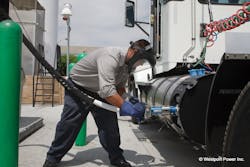Carrier survey shows high interest in LNG, but slow adoption
To determine the potential of LNG vehicle use for industrial freight, PLS Logistics Services — a provider of transportation management, technology and brokerage solutions for industrial shippers — recently surveyed senior executives at 100 of the largest industrial trucking companies in the U.S. and found that most see barriers to widespread adoption of the technology in trucking.
While respondents were generally aware of LNG-powered vehicles, 72% felt that the technology had limited adoption potential for industrial freight. Heavy-duty, over-the-road trucking operates regionally, with driver home time limited to weekends making a public refueling infrastructure essential, respondents said. In addition, over-the-road carriers require a longer operating range before refueling to remain efficient.
Also, industrial sector carriers require higher horsepower and torque to handle heavy cargo weights. Typical diesel engines used in heavy-duty fleets are 450-550 hp. with 1,600-1,800 lbs.-ft. of torque. Most LNG-powered engines fall short of this performance, PLS said, pointing out, however, that the Westport HD LNG engine does hit the lower end of the power requirement.
With predicted adoption rates low, survey respondents were asked about the primary barriers to adoption. Topping the list, at 53.6%, was the inadequacy of the LNG refueling infrastructure. As of February 2012, there were just 46 public LNG stations across the U.S., according to the U.S. Dept. of Energy. Clean Energy Fuel, Inc. has raised $450 million and has committed to build 150 LNG stations along what they call “America’s natural gas highway” — a pre-defined corridor of heavy volume freight traffic, PLS pointed out. The goal of the project, done in partnership with Pilot Flying J travel centers, is to establish stations 250 to 300 mi. apart.
The next biggest barrier to adoption (23.2%) was the higher cost of LNG vehicles, currently between $30,000–$50,000 more than diesel. Some estimate the ROI on this incremental cost at less than one year for high-mileage vehicles, PLS said. Additionally, incentives are being discussed to mitigate this increased capital expense. In January 2012, Clean Energy Fuel and Navistar announced a partnership to provide leases that effectively eliminate the equipment cost differential if the carrier signs a long-term fuel agreement with Clean Energy. The fuel would be purchased at a guaranteed minimum discount to diesel, PLS noted.
Currently, PLS added, there are bills in both the House and Senate that promote tax incentives for the purchase of LNG vehicles, and President Obama has announced his support for the legislation.
Survey results also indicated that carriers are under no pressure from customers to move toward cleaner LNG vehicles — just 3% of carriers said that their customers are actively promoting LNG adoption.
This finding is important, PLS said, because it suggests that LNG adoption by motor carriers is not currently on the radar of industrial shippers. Yet widespread adoption of LNG will reduce costs in the supply chain and generate sustained demand for natural gas drilling (and the sand, steel, equipment and industrial services needed to support drilling). One would expect shipper awareness will increase in the future given the potential to impact costs as well as revenue development, PLS noted.
Highlights from the survey showed:
- The majority of survey respondents (76.1%) were either aware of LNG technology or were actively analyzing its use.
- The majority of respondents (53.5%) believe LNG has potential in limited applications.
- A smaller group of respondents (22.5%) believe LNG is a viable alternative for current diesel engines.
- A small minority of survey respondents (2.9%) reported that shippers were actively promoting adoption of LNG by their trucking companies.
- When respondents were queried about the barriers to use of LNG from diesel, LNG refueling infrastructure (53.6%) was cited as the largest barrier, followed by the higher cost of LNG vehicles (23.6%).
“The survey results appear to be a mixed bag for natural gas supporters. On the one hand, LNG is clearly on the radar and is being actively evaluated by some of the largest trucking companies in the industrial sector,” said Greg Burns, PLS chairman and CEO. “On the other hand, less than 10% of senior executives currently believe LNG will be widely adopted of over-the-road trucking. PLS believes LNG has an important role to play as a U.S. energy source, and our future surveys will track adoption rates and attitudes towards this alternative fuel in the future.”
The United States is currently producing natural gas at record rates, with production from shale alone expected to increase 41% by 2020. As a result of increased supply and lower prices, there has been an increase in trucking industry interest in the feasibility of natural gas vehicles (NGVs) for transporting freight, Burns said.
While compressed natural gas (CNG) vehicles are appropriate for “return-to-base” vehicles like school buses, garbage trucks, and local delivery trucks, Liquefied Natural Gas (LNG) vehicles, because of their increased range, are currently a better option for long-haul, heavy-duty trucking. Adoption of LNG within the transportation industry is limited, but there are decided advantages to more widespread adoption by shippers and carriers, Burns said, including:
- Reduced fuel cost
- Reduced price volatility based on use of a domestic fuel source
- Reduced carbon emissions
- Support growth of the North American natural gas industry and the attendant economic impact
PLS Logistics Services is a provider of logistics management, brokerage and technology services for industrial shippers, handling over one million loads annually across all major freight modes: flatbed, van, LTL, rail & barge, air & ocean. The PLS network consists of over 22,000 trucking companies along with Class-1 railroads and major barge companies.
More detailed survey results are available via PLS’ website at http://www.plslogistics.com/whitepapers/PLS_LNG_Study.pdf
